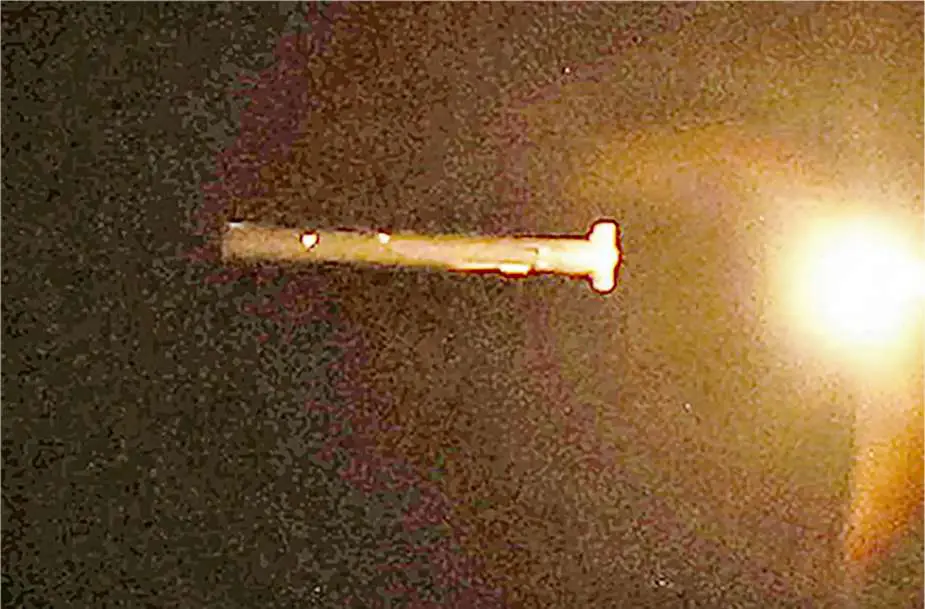Breaking news
First exposure of Taiwan's secret HF-2E Missile during launch exercise.
Taiwan's United Daily News (UDN) recently unveiled images and video clips allegedly showcasing the Hsiung Feng IIE (HF-2E) land-attack cruise missile. This missile, which has been in the Taiwanese military's arsenal for over a decade, has remained shrouded in secrecy, never being publicly displayed.
Follow Army Recognition on Google News at this link

First exposure of Taiwan's secret HF-2E Missile during launch exercise (Picture source UDN)
The images reportedly depict a night-time launch from the Jiupeng military base in Pingtung County, Southern Taiwan. The missile was said to have been airborne for an extended period. Taiwan's Central News Agency (CNA) also reported on a classified missile launch during a three-day live-fire drill at Jiupeng, though it did not confirm if the HF-2E was the missile in question.
Jiupeng base, known for its missile testing activities, is associated with the National Chung-Shan Institute of Science and Technology (NCSIST), the organization behind the HF-2E's development. Recent incidents at the base include an explosion during missile propellant disposal and an unspecified missile detonating mid-air during testing.
The released images hint at the HF-2E's external design, resembling the U.S. Tomahawk missile. It is believed to be subsonic, with a cylindrical body, blunt nose, tail-end fins, and rear pop-out wings.
Despite limited official data on the HF-2E, its unveiling comes amid rising concerns over potential Chinese military actions across the Taiwan Strait. The missile, along with others like the Yun Feng, bolsters Taiwan's deterrence strategy. There are believed to be two HF-2E variants, with the baseline model targeting 300 to 600 kilometers and the extended-range Hsiung Sheng variant reaching 1,000 to 1,500 kilometers.
The HF-2E reportedly uses GPS-assisted inertial navigation and terrain contour matching (TERCOM) for guidance. Some speculate it also has an imaging infrared seeker for increased accuracy.
The Hsiung Feng IIE, developed by NCSIST, has been operational since 2011. Contrary to some reports, it is not a derivative of the Hsiung Feng 2 anti-ship missile. The HF-2E is a distinct design, mirroring the U.S. Navy's Tomahawk cruise missile's function. Weighing between 3,300-3,500 pounds, its primary role is to target military assets, especially air-defense units and command centers.
The missile's development began in 2001, with multiple test firings between 2004 and 2005. The baseline HF-2E underwent operational evaluation in 2005, with a more advanced version tested in 2007. The missile received significant upgrades in 2017.
The baseline HF-2E Block I cruise missile boasts a range of approximately 700 kilometers. It uses inertial navigation with GPS and TERCOM updates for guidance, with terminal phase guidance involving infrared homing.
Production began in 2005, with unit costs around $3.08 million (2003 USD) each. By 2011, the missile was greenlit for full production, primarily deployed via ground-mobile launchers. The improved Hsiung Sheng variant, targeting distant Chinese cities, was delivered to the Air Force in January 2021.
The HF-2E's general characteristics include a range of 600 to 2,000 kilometers, a top speed of Mach 0.75 to 0.85, and a launch weight of 3,000 to 3,500 pounds. Its accuracy is within 10 meters, and it carries a 200-kilogram warhead.
Recent years have seen a significant uptick in tensions, with China increasing its military activities around the island, including frequent air force incursions into Taiwan's air defense identification zone. These actions are often interpreted as attempts to intimidate Taiwan and signal Beijing's displeasure with any moves toward formal independence. On the international stage, the situation is further complicated by the involvement of major powers, particularly the United States, which, while not officially recognizing Taiwan as a sovereign state, has committed to its defense and regularly conducts arms sales to the island. The Taiwan Strait, thus, remains a potential flashpoint, with any miscalculation or escalation bearing the risk of drawing larger global powers into a broader conflict.
The potential HF-2E images shed light on Taiwan's military readiness, even if the missile's exact role remains ambiguous.























